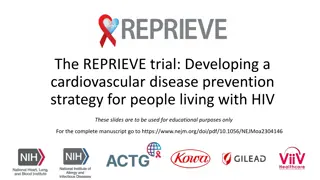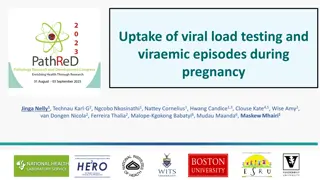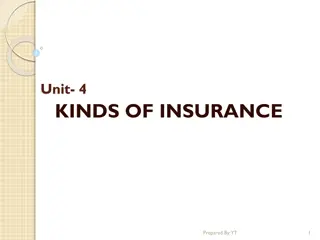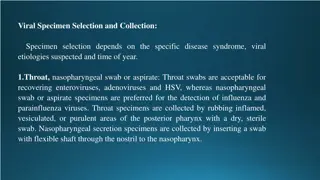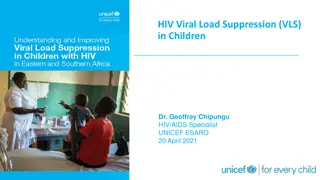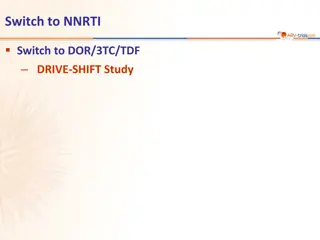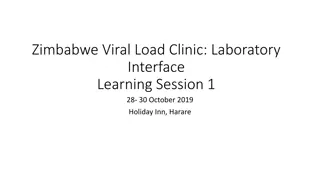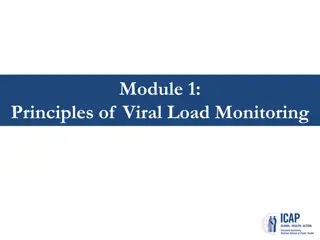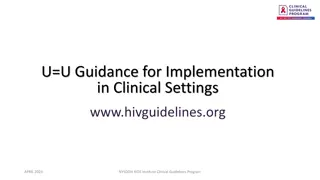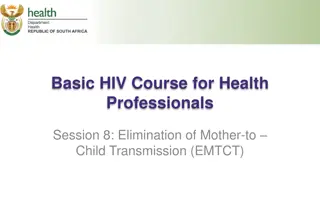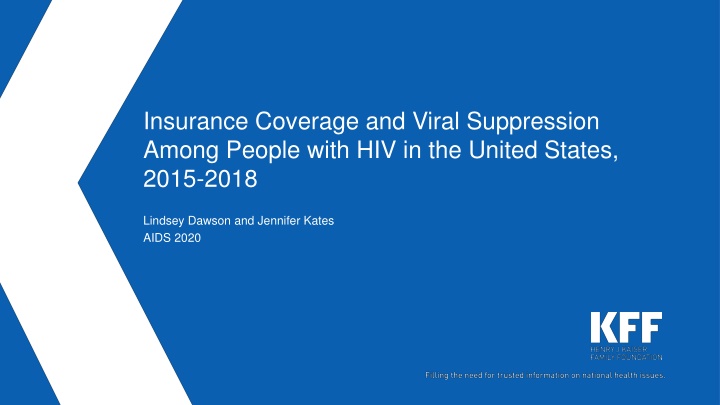
Insurance Coverage and Viral Suppression Among People with HIV in the US 2015-2018 Study
Explore the impact of health insurance coverage on viral suppression among individuals with HIV in the United States between 2015-2018. The study reveals Medicaid as the primary coverage source, followed by private insurance, with stable overall coverage rates post ACA implementation.
Download Presentation

Please find below an Image/Link to download the presentation.
The content on the website is provided AS IS for your information and personal use only. It may not be sold, licensed, or shared on other websites without obtaining consent from the author. If you encounter any issues during the download, it is possible that the publisher has removed the file from their server.
You are allowed to download the files provided on this website for personal or commercial use, subject to the condition that they are used lawfully. All files are the property of their respective owners.
The content on the website is provided AS IS for your information and personal use only. It may not be sold, licensed, or shared on other websites without obtaining consent from the author.
E N D
Presentation Transcript
Insurance Coverage and Viral Suppression Among People with HIV in the United States, 2015-2018 Lindsey Dawson and Jennifer Kates AIDS 2020
Background Health insurance coverage and access to care improve health outcomes, including viral suppression, for people with HIV in the United States. Prior research has demonstrated that implementation of the Affordable Care Act (ACA) in 2014 increased coverage among people with HIV and that certain forms of coverage are positively correlated with sustained viral suppression. We provide a 2018 update, the latest nationally representative data in this area, as well as trends over time.
Methods This analysis is based on 2015-2018 data from the Medical Monitoring Project (MMP), a Centers for Disease Control and Prevention (CDC) surveillance system which produces nationally representative estimates of behavioral and clinical characteristics of adults with diagnosed HIV in the United States. We estimated weighted percentages of adults with the following types of health care coverage, grouping people into mutually exclusive categories, using the following hierarchy: Private coverage (with breakouts for employer coverage and marketplace coverage), Medicaid, Medicare, and other (including Tricare/CHAMPUS, Veteran s Administration, or city/county coverage). Rao-Scott chi-square tests were used for statistical comparisons to assess differences between groups.
Findings Coverage In 2018, Medicaid was the single largest source of coverage for adults with HIV, covering 4 in 10, followed by private insurance (35%). Just 1 in 10 are uninsured. (Fig. 1) Overall coverage rates have remained stable for this population since 2015, the year after full implementation of the ACA. (Fig. 2)
Figure 1: Insurance Coverage Among Adults with HIV, 2018 Uninsured 11% Other 7% Private 35% Medicare 8% Medicaid 40% SOURCE: KFF/CDC Analysis of Medical Monitoring Project data, 2018.
Figure 2: Insurance Coverage Among Adults with HIV, 2015-2018 50% 40% 30% 20% 10% 0% 2015 2016 2017 2018 Private Medicaid Medicare Uninsured NOTE: No significant change between coverage groups in 2015 and 2018. SOURCE: KFF/CDC Analysis of Medical Monitoring Project data, 2015-2018.
Findings Coverage II Coverage patterns among adults with HIV differ from those of the general population. (Fig. 3) Medicaid plays a much larger role for people with HIV (40% compared to 15%). Conversely, the general population is more likely to be privately insured (56% compared to 35%). Uninsurance rates are comparable between the two populations. In states that have expanded Medicaid under the ACA, people with HIV are significantly more likely to be covered by Medicaid than states that have not expanded (46% compared to 30%) and less likely to be uninsured (6% compared to 20%). (Fig. 4)
Figure 3: Insurance Coverage Among Adults with HIV Compared to Adults in the General Population, 2018 56% 40% 35% 18% 15% 11% 10% 8% 1% 7% Private Medicaid Medicare Adult General Population Other Uninsured Adults with HIV SOURCE: Coverage among people with HIV - KFF/CDC Analysis of Medical Monitoring Project data, 2018. Coverage among general population - Kaiser Family Foundation estimates based on the Census Bureau's American Community Survey, 2018. https://www.kff.org/other/state- indicator/adults-19-64/ NOTE: Data sources are different for people with HIV and the general population and statistical testing was not performed.
Figure 4: Insurance Coverage Among Adults with HIV by State Medicaid Expansion Status, 2018 Uninsured* 6% Uninsured* 20% Medicare + Other 15% Medicare + Other 14% Medicaid* 46% Medicaid* 30% Private 36% Private 34% Non-Expansion State Medicaid Expansion State NOTES: * Coverage rates in Medicaid expansion vs non-expansion states significantly different (p>.001) SOURCE: KFF/CDC Analysis of Medical Monitoring Project data, 2018.
Findings Coverage II There are also coverage differences by gender and race/ethnicity among people with HIV. Male adults with HIV are more likely to have private coverage and Medicare while females are more likely to have Medicaid. Rates of uninsurance do not differ significantly by gender. (Fig. 5) White adults with HIV are more likely than Blacks and Hispanics to have private insurance and Medicare and are less likely than Blacks to have Medicaid. Blacks and Hispanics are more than three times as likely as Whites to be uninsured. (Fig.5)
Figure 5: Insurance Coverage Among Adults with HIV, by Gender and Race/Ethnicity, 2018 Gender Race/Ethnicity 45% 45%* 54% 38% 35% 31%* 28%* 39% 36% 15%* 23% 14%* 11% 7%* 5%* 11% 4% 10% 8% 6% Private** Medicaid** Medicare* Uninsured Private Medicaid Medicare Uninsured Male Female White Black Hispanic NOTES: * Coverage rates significantly different between males and females (p<.05) **Coverage rates significantly different between males and females (p<.001) SOURCE: KFF/CDC Analysis of Medical Monitoring Project data, 2018. NOTE: *Coverage rates significantly different compared to whites. (p<.001)
Findings Ryan White The Ryan White HIV/AIDS Program continues to play an important role in providing outpatient care and support services to people with HIV, regardless of insurance coverage. In 2018, nearly half (46%) of adults with HIV found support through the program. Ryan White plays an especially important role for the uninsured, 82% of whom receive program services. Sixty-two percent (62%) of those on Medicare receive Ryan White support. Almost 4 in 10 of those with private insurance (38%) receive assistance through the program, a share that is significantly higher among those with marketplace coverage (56%) compared to employer- based coverage (32%). (Fig. 6)
Figure 6: Receipt of Ryan White Support Among Adults with HIV, by Insurance Coverage, 2018 82% 62% 56% 46% 40% 38% 32% Private Overall Marketplace Employer Overall (row%) Private Medicaid Medicare Uninsured NOTE: Ryan White support includes self attestation to receiving coverage through Ryan White, including ADAP. SOURCE: KFF/CDC Analysis of Medical Monitoring Project data, 2018.
Findings Viral Suppression Viral suppression, particularly sustained viral suppression (defined as having an undetectable viral load over all tests in the preceding 12 months), affords optimal individual health outcomes and provides substantial public health benefit. In 2018, 68% of people with HIV were virally suppressed at last test and 62% had sustained viral suppression. (Fig. 7) The proportion of people with sustained viral suppression was significantly higher among those with private insurance and among those with Medicare, compared to the uninsured. Other differences in viral suppression between those with coverage and the uninsured were not significant. (Fig. 7)
Figure 7: Sustained Viral Suppression Among Adults with HIV, by Insurance Coverage, 2018 69%** 68% 67%* 62% 59% 54% Overall Private Medicaid Medicare Uninsured Viral Suppression at Last Test Sustained Viral Suppression NOTES: * Viral suppression rate greater than that of the uninsured (p>.05) ** Viral suppression rate greater than that of the uninsured (p>.001) Sustained viral suppression is defined as having an undetectable viral load over all tests in the preceding 12 months. SOURCE: KFF/CDC Analysis of Medical Monitoring Project data, 2018.
Findings Viral Suppression II Ryan White support appears to make a significant difference in achieving sustained viral suppression. Overall, those with Ryan White support were significantly more likely to have sustained viral suppression compared to those without and this trend was observed across all coverage types, and was especially apparent among the uninsured. (Fig. 8)
Figure 8: Ryan White Support and Sustained Viral Suppression Among Adults with HIV, by Insurance Coverage 75% 73% 68% 64% 64% 60% 58% 58% 56% 26% Overall** Private** Medicaid* Medicare* Uninsured** Coverage & Ryan White Coverage with No Ryan White Notes: * Rate of viral suppression significantly different between those with coverage source & Ryan White vs. those with coverage source and no Ryan White, (p<.05). ** Rate of viral suppression significantly different between those with coverage source & Ryan White vs. those with coverage source and no Ryan White, (p<.001). Sustained viral suppression is defined as having an undetectable viral load over all tests in the preceding 12 months. Source: KFF/CDC Analysis of Medical Monitoring Project data, 2018.
Conclusion The ACA has made a significant difference in expanding insurance coverage among people with HIV. In 2018, the uninsurance rate among people with HIV was similar to that of the public at large. Medicaid represented the single largest source of coverage for people with HIV, particularly in Medicaid expansion states, followed closely by private insurance. We observed significant differences in coverage by gender and race/ethnicity, with notable disparities related to rates of uninsurance by race/ethnicity. The Ryan White Program is a critical source of care, treatment, and support for people with HIV, especially for the uninsured but also for a substantial share of those with coverage. Certain insurance sources and support from Ryan White were associated with sustained viral suppression, a crucial indicator of optimizing the individual and public health benefits associated with antiretroviral treatment.
Acknowledgments The authors wish to thank Dr. Sharoda Dasgupta, Dr. Linda Beer, and Dr. Yunfeng Tie of the CDC, who were instrumental in this work in providing access to data, guidance, and conducting statistical analysis.


